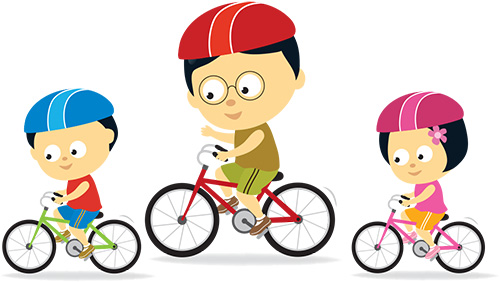- Overview
- Welcome
- Areas of Instruction
- Bicycle Safety
- Gun Safety
- Motor Vehicle Safety
- School Bus Safety
- Railroad Safety
- Pedestrian Safety
- Fire Safety
- Electrical Safety
- 9-1-1 Familiarization
- Stranger Danger
- Tornado Safety
- Poison Danger
- Water Safety
- Testing
- Teacher Copy
- Student Copy
- Evaluation Form
- Summary
- Download Guide
- Content Standards
- Homework Assignment
Bicycle Safety

It's a beautiful day - the sun is shining, the birds are singing. What could be more perfect than a bike ride? But wait! Before you pull your bike out of the garage, let's find out how to stay safe on two (or four) wheels.
WHY IS BICYCLE SAFETY SO IMPORTANT?
Every year, over 400,000 children go to the emergency room because of bike accidents. Some are very serious and most of the serious accidents are from head injuries because a helmet wasn't worn.
HELMET HOW-TO
First of all, ALWAYS wear a helmet. Bike helmets are so important!
Always wear a helmet that fits your head. You don't want it too big or too small. Never wear a hat under your helmet.
Once you have the right helmet, you need to wear it the right way - flat on your head, covering your forehead with the strap always fastened.
HELMET ON, NOW WHAT?
- Riding a bike that is the right size for you helps keep you safe. When you are on your bicycle, stand straddling the top bar of your bike so that both feet are flat on the ground. There should be 1 to 3 inches of space between you and the top bar.
- Here's a safety checklist to go over with your mom and dad: Make sure your seat, handlebars, and wheels fit tightly. Check your brakes to be sure they work well and aren't sticking. Check your tires to make sure they have enough air in them.
- It makes sense to wear very bright colors when you're biking. Choose a color that makes you easy to see.
- Make sure you don't have anything that will get caught in your bike chain or wheels, such as loose pants legs, backpack straps, or shoelaces.
- Wear the right shoes - sneakers - when you bike. Sandals, shoes with heels, slippers, and cleats won't help you grip the pedals. And NEVER go riding barefoot!
- Do not wear headphones - you won't be able to hear what's going on around you.
- Avoid riding at night. If you have to ride at night, use reflectors, lights and reflective clothing.
Riding a bike can be a lot of fun! But just like your parents who have to be careful and always obey the rules when they are driving a car, there are rules you need to follow when you ride your bike on the road. It's easy to fall off a bike and get hurt, especially if you don't know the rules of the road or if your bike isn't working right.
Basic Bike-Riding Rules
- Ride on sidewalks or bike paths when they are available. If you have to ride in the street, always ride WITH traffic, as near to the right as possible.
- When entering a sidewalk, path, or driveway, make a complete stop. Look left, right, and then back to the left. Be careful not to run into people who are walking on the sidewalk, path, or driveway. Pedestrians always have the right of way so be sure and give an audible warning (bell, horn, word) if you are going to pass them.
- When crossing the street with a grownup, WALK, don't ride your bicycle. Look in all directions before crossing and cross at intersections using the crosswalk and following traffic signals.
- Children should never ride their bicycles at night.
- Keep an eye on the road ahead and watch out for obstacles in the road such as:
- wet leaves
- broken glass
- big puddles
- people in your path
- cracks in the road
- litter
- potholes
- gravel or rocks
- All of these can cause you to lose control.
- Stop at all stop signs and obey street lights just as cars do. Know your road signs and obey them. A smart biker follows the rules of the road.
- Never ride out from behind parked cars and don't ride too close to parked cars. Someone could open their door unexpectedly and well, yikes!
- Always be prepared to stop. Keep your hands on or close to the brakes, with both hands on the handlebars unless giving a hand signal.
- Only one person should ride on a bike at a time unless there are seats for two. Keep one hand on the handlebars at all times.
- Never hitch a ride by holding on to a car or truck.
- When more than one bicycler is riding, ride in a straight line, never two or more side by side.
- Use proper hand signals when turning.
- Most important, be predictable. Ride in a straight line. Look behind you before changing lanes or turning, use your hand signals and drive carefully.